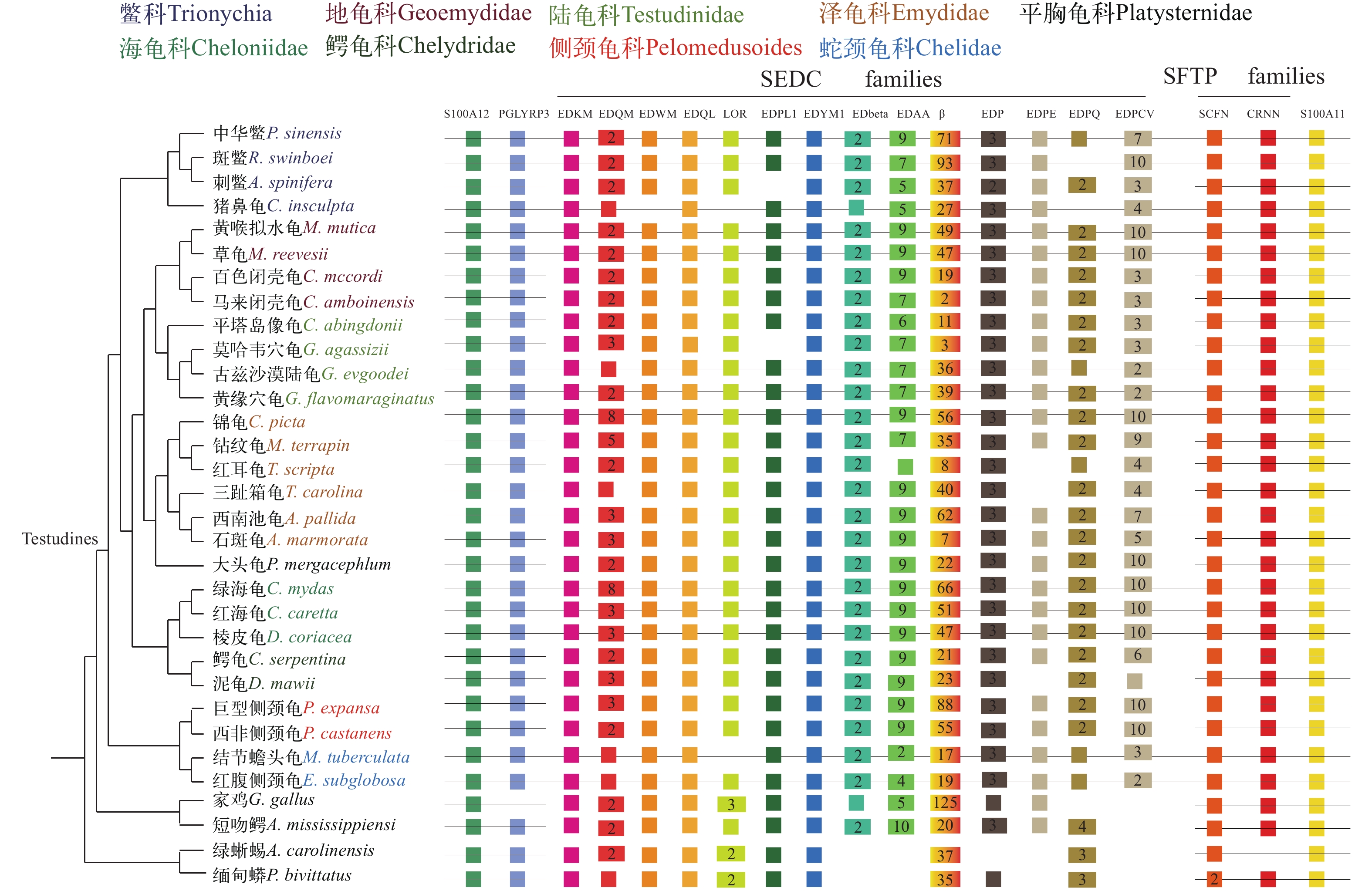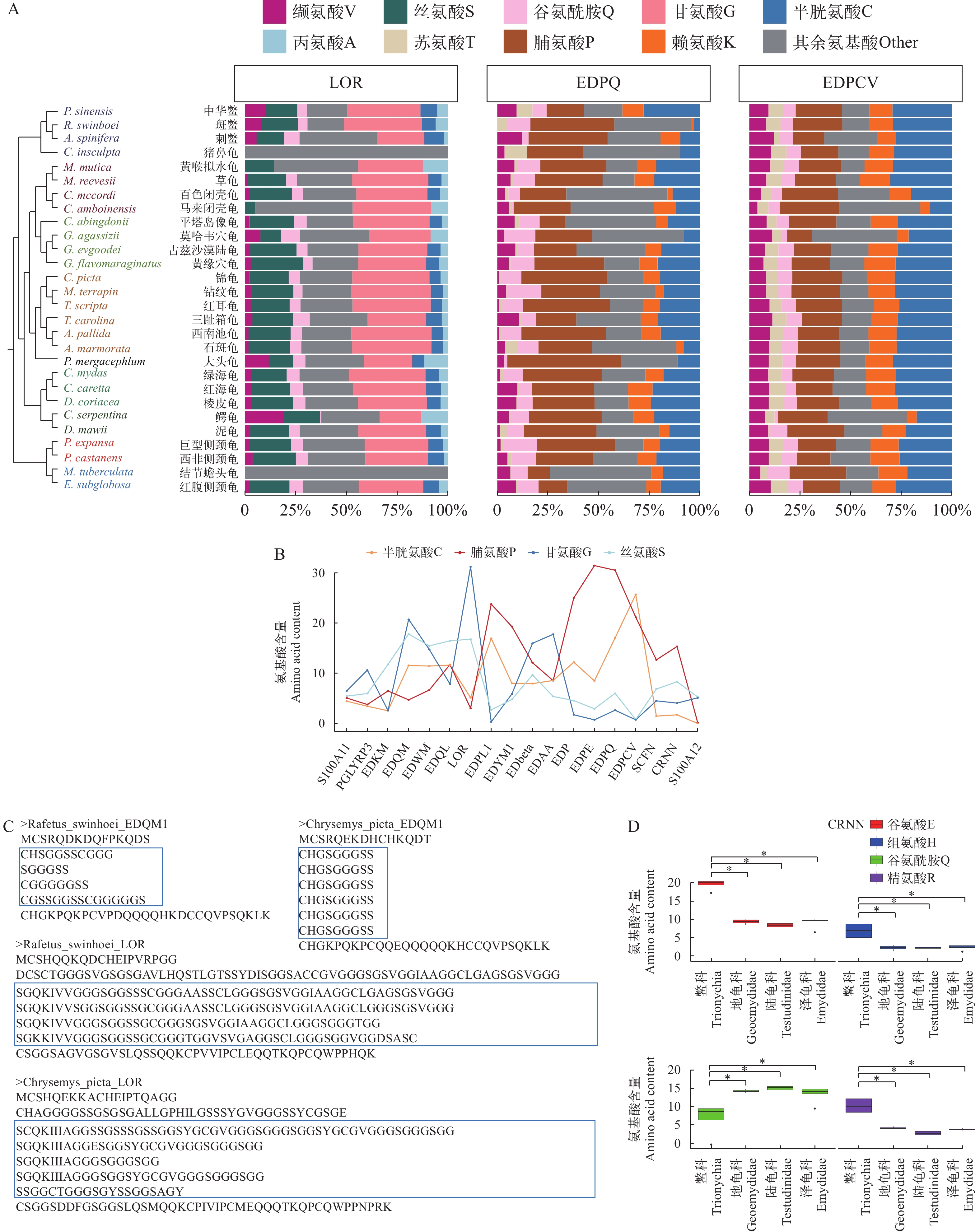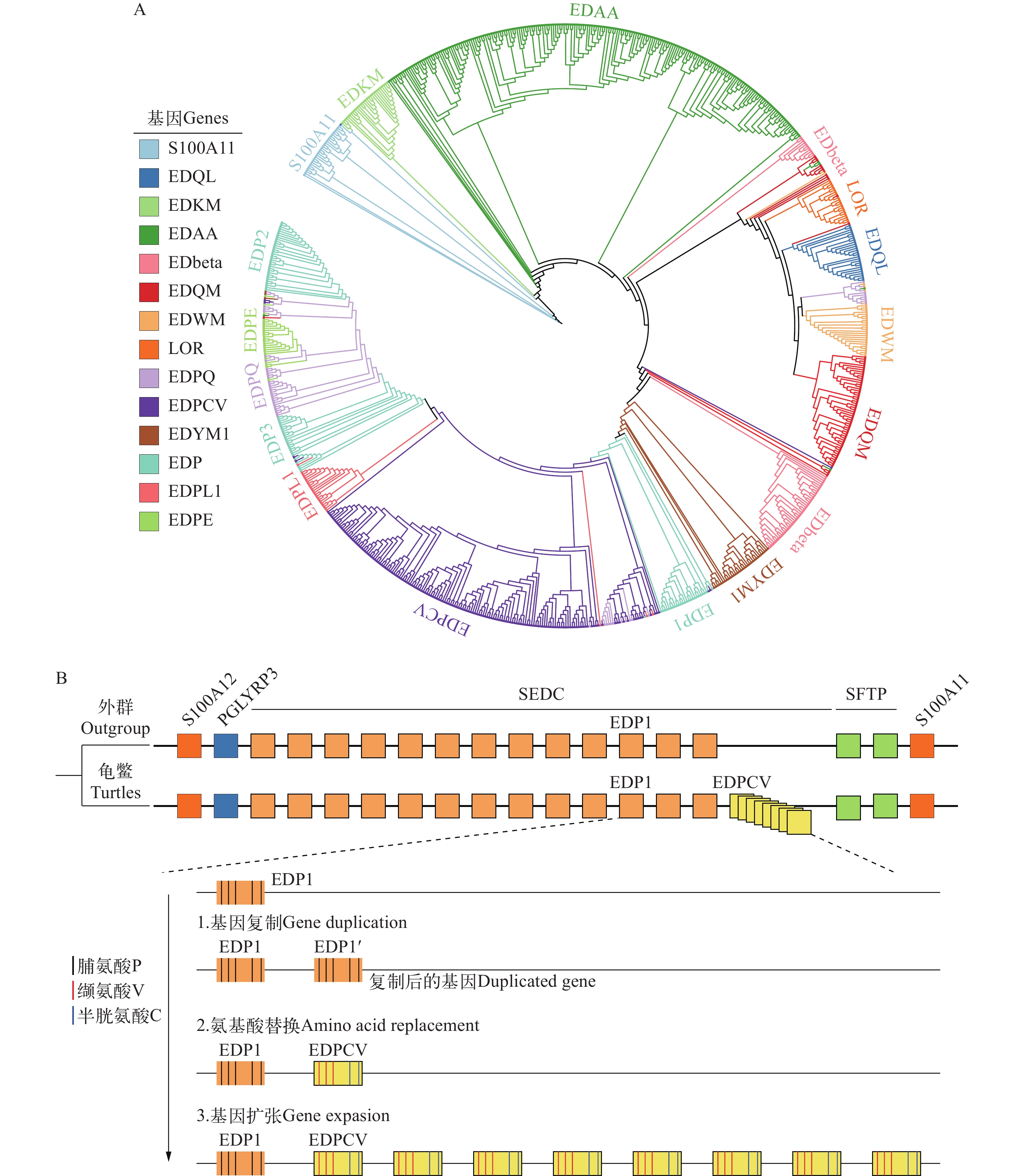COMPARATIVE GENOMIC IDENTIFICATION AND ANALYSES OF EPIDERMAL DIFFERENTIATION COMPLEX GENES IN TURTLES
-
摘要:
发掘龟鳖表皮分化复合体(Epidermal Differentiation Complex, EDC)基因的序列特征和进化有助于解析其甲壳表皮特征的遗传基础和演化历史。文章对28个龟鳖的EDC基因进行了比较基因组学鉴定, 染色体定位、氨基酸含量、结构域、蛋白空间结构分析和演化历史的重塑。研究结果表明龟鳖EDC基因具有和其他爬行动物相同的四类基因家族, 其中简单表皮复合体(Simple epidermal differentiation complex, SEDC)基因家族成员通过多次串联重复事件, 实现基因扩张。龟鳖SEDC蛋白氨基酸组成高度多样化, SEDC和S100融合蛋白(S100-fused type proteins, SFTP)蛋白氨基酸含量存在类群(硬壳、软壳、棱皮)特异性, 这支持了龟鳖甲壳表皮结构的多样性。龟鳖S100钙结合蛋白A (S100 calcium binding protein A, S100A)和SFTP功能域和蛋白空间结构高度保守, 仅肽聚糖识别蛋白(Peptidolycan recognition protein3, PGLYRP3)的motif3存在鳖科特异性丢失。龟鳖特有的含有脯氨酸、半胱氨酸和缬氨酸的表皮分化蛋白(Epidermal Differentiation protein rich in Proline, Cysteine and Valine, EDPCV)来源于富含脯氨酸的表皮分化蛋白(Epidermal differentiation protein rich in proline 1, EDP1), 富含半胱氨酸和缬氨酸, 通过串联复制实现基因扩张。研究为进一步研究EDPCV在龟鳖中的作用提供了数据基础和理论依据。
Abstract:The epidermal differentiation complex (EDC) is a cluster of genes highly associated with keratinocytes differentiation and epidermal keratinization. This gene cluster plays an important role in the differentiation of epidermal tissues in amniotes, the formation of various skin appendages, and the keratinization process. Therefore, exploring the sequence characteristics and evolution of EDC genes in turtles can help elucidate the genetic basis and evolutionary history of their shell epidermis traits. Currently, there is a lack of systematic comparative analysis of the sequence characteristics and evolutionary levels of EDC genes across different turtle groups. This study performed comparative genomics identification of EDC in 28 turtles, including chromosomal localization, amino acid composition, domain analysis, protein spatial structure analysis, and the reconstruction of evolutionary history. The EDC genes in turtles exhibit the same four gene families found in other reptiles, with members of the SEDC gene family expanding through multiple tandem repeat events. The amino acid composition of turtle SEDC proteins is highly diverse, with SEDC and SFTP protein amino acid content showing group-specific characteristics (hard-shelled, soft-shelled, leatherback), which supports the diversity of shell epidermal structures in turtles. The functional domains and protein spatial structures of S100A and SFTP are highly conserved across turtle species, with motif 3 of PGLYRP3 showing a loss specific to the family Trionychidae. The turtle-specific EDPCV originates from EDP1, and mutations have enriched cysteine and valine, facilitating gene expansion through tandem duplication. This study provides a data foundation and theoretical basis for further research on the role of EDPCV in turtles.
-
Keywords:
- EDC /
- Amino acid content /
- Gene expansion /
- EDPCV gene /
- Turtles
-
-
图 1 龟鳖与其他爬行动物EDC基因的基因组分布
左图为龟鳖和其他爬行动物的物种树; 右图显示了表皮分化复合体(EDC) 基因的组成; 着色的矩形代表 EDC 基因的不同成员; 连接矩形的实线代表基因间的物理基因组连锁; 矩形中的数字表示基因数量
Figure 1. Genomic distribution of EDC genes in turtles and other reptiles
The left side illustrates a species tree of turtles and other reptiles, while the right side displays the distribution of the Epidermal Differentiation Complex (EDC) genes. Colored squares represent the identified EDC genes, and solid lines connecting the gene boxes indicate physical genomic linkage. The number in the rectangle indicates the gene numbers
图 2 龟鳖EDC蛋白氨基酸组成
A. 龟鳖不同物种 EDC 蛋白的氨基酸组成; B. 龟鳖EDC基因氨基酸含量均值百分比趋势图; 蛋白展示顺序和图 1中EDC基因分布顺序一致; C. 鳖、龟SEDC示例(EDQM1和LOR)蛋白氨基酸序列, 重复序列用蓝色矩形标记; D. 不同龟鳖科间 CRNN 蛋白氨基酸组成的比较; 统计显著性为: 0.01<*P<0.05
Figure 2. Amino acid contents of turtle EDC proteins
A. The diagram shows the amino acid contents of EDC proteins across turtle species; B. The average distributions of amino acid content in turtles. The protein data are shown in the order of the corresponding genes in the EDC (Fig. 1); C. Amino acid sequences of exemplary SEDC proteins (EDQM1 and LOR) from softshell and hardshell turtles are shown, with sequence repeats highlighted in blue rectangles; D. The distribution of amino acid content of CRNN protein sequences across various turtle families; The level of significance: 0.01<*P<0.05
图 3 龟鳖目SFTP的空间结构和PGLYRP3的motif分析
A. 鳖科和陆龟总科SFTP和S100A11蛋白的空间结构, 红色α螺旋标记为S100结构域; B. 矩形标记为 PGLYRP3蛋白motif区域
Figure 3. Spatial structure of SFTP and motif analysis of PGLYRP3 in turtles
A. The spatial structures of the SFTP and S100A11 proteins in the families of Trionychia and Testudinoidea, with the red α-helix labeled as the S100 domain; B. The rectangle marks the protein motif regions of the PGLYRP3
-
[1] Henry J, Toulza E, Hsu C Y, et al. Update on the epidermal differentiation complex [J]. Frontiers in Bioscience (Landmark edition), 2012, 17(4): 1517-1532.
[2] Sobiak B, Graczyk-Jarzynka A, Leśniak W. Comparison of DNA methylation and expression pattern of S100 and other epidermal differentiation complex genes in differentiating keratinocytes [J]. Journal of Cellular Biochemistry, 2016, 117(5): 1092-1098. doi: 10.1002/jcb.25392
[3] Mischke D, Korge B P, Marenholz I, et al. Genes encoding structural proteins of epidermal cornification and S100 calcium-binding proteins form a gene complex (“epidermal differentiation complex”) on human chromosome 1q21 [J]. Journal of Investigative Dermatology, 1996, 106(5): 989-992. doi: 10.1111/1523-1747.ep12338501
[4] Holthaus K B, Eckhart L. Development-associated genes of the epidermal differentiation complex (EDC) [J]. Journal of Developmental Biology, 2024, 12(1): 4. doi: 10.3390/jdb12010004
[5] Kypriotou M, Huber M, Hohl D. The human epidermal differentiation complex: cornified envelope precursors, S100 proteins and the ‘fused genes’ family [J]. Experimental Dermatology, 2012, 21(9): 643-649. doi: 10.1111/j.1600-0625.2012.01472.x
[6] Mlitz V, Hussain T, Tschachler E, et al. Filaggrin has evolved from an “S100 fused-type protein” (SFTP) gene present in a common ancestor of amphibians and mammals [J]. Experimental Dermatology, 2017, 26(10): 955-957. doi: 10.1111/exd.13317
[7] Kalinin A E, Kajava A V, Steinert P M. Epithelial barrier function: assembly and structural features of the cornified cell envelope [J]. BioEssays, 2002, 24(9): 789-800. doi: 10.1002/bies.10144
[8] Holthaus K B, Lachner J, Ebner B, et al. Gene duplications and gene loss in the epidermal differentiation complex during the evolutionary land-to-water transition of cetaceans [J]. Scientific Reports, 2021, 11(1): 12334. doi: 10.1038/s41598-021-91863-3
[9] Strasser B, Mlitz V, Fischer H, et al. Comparative genomics reveals conservation of filaggrin and loss of caspase-14 in dolphins [J]. Experimental Dermatology, 2015, 24(5): 365-369. doi: 10.1111/exd.12681
[10] Davis A, Greenwold M J. Evolution of an epidermal differentiation complex (EDC) gene family in birds [J]. Genes, 2021, 12(5): 767. doi: 10.3390/genes12050767
[11] Strasser B, Mlitz V, Hermann M, et al. Evolutionary origin and diversification of epidermal barrier proteins in amniotes [J]. Molecular Biology and Evolution, 2014, 31(12): 3194-3205. doi: 10.1093/molbev/msu251
[12] Holthaus K B, Strasser B, Sipos W, et al. Comparative genomics identifies epidermal proteins associated with the evolution of the turtle shell [J]. Molecular Biology and Evolution, 2016, 33(3): 726-737. doi: 10.1093/molbev/msv265
[13] Holthaus K B, Mlitz V, Strasser B, et al. Identification and comparative analysis of the epidermal differentiation complex in snakes [J]. Scientific Reports, 2017(7): 45338. doi: 10.1038/srep45338
[14] Holthaus K B, Strasser B, Lachner J, et al. Comparative analysis of epidermal differentiation genes of crocodilians suggests new models for the evolutionary origin of avian feather proteins [J]. Genome Biology and Evolution, 2018, 10(2): 694-704. doi: 10.1093/gbe/evy035
[15] Holthaus K B, Alibardi L, Tschachler E, et al. Identification of epidermal differentiation genes of the tuatara provides insights into the early evolution of lepidosaurian skin [J]. Scientific Reports, 2020, 10(1): 12844. doi: 10.1038/s41598-020-69885-0
[16] Sachslehner A P, Eckhart L. Evolutionary diversification of epidermal barrier genes in amphibians [J]. Scientific Reports, 2022, 12(1): 13634. doi: 10.1038/s41598-022-18053-7
[17] Moltrasio C, Romagnuolo M, Marzano A V. Epigenetic mechanisms of epidermal differentiation [J]. International Journal of Molecular Sciences, 2022, 23(9): 4874. doi: 10.3390/ijms23094874
[18] Simpson C L, Patel D M, Green K J. Deconstructing the skin: cytoarchitectural determinants of epidermal morphogenesis [J]. Nature Reviews Molecular Cell Biology, 2011, 12(9): 565-580. doi: 10.1038/nrm3175
[19] Alibardi L. Corneous beta proteins of the epidermal differentiation complex (EDC) form large part of the corneous material of claws and rhamphothecae in turtles [J]. Protoplasma, 2020, 257(4): 1123-1138. doi: 10.1007/s00709-020-01494-0
[20] Yu J, Yu D W, Checkla D M, et al. Human hair keratins [J]. Journal of Investigative Dermatology, 1993, 101(1): S56-S59. doi: 10.1016/0022-202X(93)90501-8
[21] Shelley W B. Physiology, biochemistry, and molecular biology of the skin [J]. JAMA, 1992, 268(4): 545.
[22] Scott I R, Harding C R, Barrett J G. Histidine-rich protein of the keratohyalin granules Source of the free amino acids, urocanic acid and pyrrolidone carboxylic acid in the stratum corneum [J]. Biochimica et Biophysica Acta (BBA) - General Subjects, 1982, 719(1): 110-117. doi: 10.1016/0304-4165(82)90314-2
[23] Candi E, Schmidt R, Melino G. The cornified envelope: a model of cell death in the skin [J]. Nature Reviews Molecular Cell Biology, 2005, 6(4): 328-340. doi: 10.1038/nrm1619
[24] Bragulla H H, Homberger D G. Structure and functions of keratin proteins in simple, stratified, keratinized and cornified epithelia [J]. Journal of Anatomy, 2009, 214(4): 516-559. doi: 10.1111/j.1469-7580.2009.01066.x
[25] Li Y I, Kong L, Ponting C P, et al. Rapid evolution of Beta-keratin genes contribute to phenotypic differences that distinguish turtles and birds from other reptiles [J]. Genome Biology and Evolution, 2013, 5(5): 923-933. doi: 10.1093/gbe/evt060
[26] Moustakas-Verho J E, Zimm R, Cebra-Thomas J, et al. The origin and loss of periodic patterning in the turtle shell [J]. Development, 2014, 141(15): 3033-3039. doi: 10.1242/dev.109041
[27] Moustakas-Verho J E, Cherepanov G O. The integumental appendages of the turtle shell: an evo-Devo perspective [J]. Journal of Experimental Zoology Part B: Molecular and Developmental Evolution, 2015, 324(3): 221-229. doi: 10.1002/jez.b.22619
[28] Dalla Valle L, Nardi A, Toni M, et al. Beta-keratins of turtle shell are Glycine-proline-tyrosine rich proteins similar to those of crocodilians and birds [J]. Journal of Anatomy, 2009, 214(2): 284-300. doi: 10.1111/j.1469-7580.2008.01030.x
[29] 黄保友, 楼灵媛, 樊嘉伟, 等. 基于全基因组的龟鳖目 Hox 基因序列特征及进化分析 [J]. 水生生物学报, 2023, 47(10): 1617-1627.] doi: 10.7541/2023.2022.0465 Huang B Y, Lou L Y, Fan J W, et al. Evolutionary analyses and sequence feature of Hox genes in turtles [J]. Acta Hydrobiologica Sinica, 2023, 47(10): 1617-1627. [ doi: 10.7541/2023.2022.0465
[30] Ogushi K. Anatomische Studien an der japanischen dreikralligen Lippenschildkröte (Trionyx japanicus). I. Mitteilung [J]. Morphologisches Jahrbuch, 1911(43): 1-106.
[31] Nagashima H, Shibata M, Taniguchi M, et al. Comparative study of the shell development of hard- and soft-shelled turtles [J]. Journal of Anatomy, 2014, 225(1): 60-70. doi: 10.1111/joa.12189
[32] Gilbert S F, Cebra-Thomas J A, Burke A C, et al. How the Turtle Gets Its Shell [M]. Biology of Turtles: Structures to Strategies. CRC Press, Boca Raton, 2007.
[33] Eckhart L, Lippens S, Tschachler E, et al. Cell death by cornification [J]. Biochimica et Biophysica Acta (BBA) - Molecular Cell Research, 2013, 1833(12): 3471-3480. doi: 10.1016/j.bbamcr.2013.06.010
[34] Yenmiş M, Ayaz D. The story of the finest armor: developmental aspects of reptile skin [J]. Journal of Developmental Biology, 2023, 11(1): 5. doi: 10.3390/jdb11010005
[35] Alibardi L. Adaptation to the land: The skin of reptiles in comparison to that of amphibians and endotherm amniotes [J]. Journal of Experimental Zoology Part B: Molecular and Developmental Evolution, 2003, 298B(1): 12-41. doi: 10.1002/jez.b.24
[36] Altschul S F, Gish W, Miller W, et al. Basic local alignment search tool [J]. Journal of Molecular Biology, 1990, 215(3): 403-410. doi: 10.1016/S0022-2836(05)80360-2
[37] Yu X J, Zheng H K, Wang J, et al. Detecting lineage-specific adaptive evolution of brain-expressed genes in human using Rhesus macaque as outgroup [J]. Genomics, 2006, 88(6): 745-751. doi: 10.1016/j.ygeno.2006.05.008
[38] Birney E, Clamp M, Durbin R. GeneWise and genomewise [J]. Genome Research, 2004, 14(5): 988-995. doi: 10.1101/gr.1865504
[39] Wilkins D. gggenes: draw gene arrow maps in ‘ggplot2’ [M]. R package version 0.4. 0. 2019.
[40] Kolde R, Kolde M R. Package ‘pheatmap’ [J]. R package, 2015, 1(7): 790.
[41] Thomson R C, Spinks P Q, Shaffer H B. A global phylogeny of turtles reveals a burst of climate-associated diversification on continental margins [J]. Proceedings of the National Academy of Sciences of the United States of America, 2021, 118(7): e2012215118.
[42] Wickham H. Reshaping data with thereshapePackage [J]. Journal of Statistical Software, 2007, 21(12): 1-20.
[43] Wickham H. ggplot2 [J]. Wiley Interdisciplinary Reviews, 2011, 3(2): 180-185. doi: 10.1002/wics.147
[44] Cramer P. AlphaFold2 and the future of structural biology [J]. Nature Structural & Molecular Biology, 2021, 28(9): 704-705.
[45] Mooers B H M. Shortcuts for faster image creation in PyMOL [J]. Protein Science, 2020, 29(1): 268-276. doi: 10.1002/pro.3781
[46] Bailey T L, Boden M, Buske F A, et al. MEME SUITE: tools for motif discovery and searching [J]. Nucleic Acids Research, 2009, 37(Web Server issue): W202-W208.
[47] Yang M, Derbyshire M K, Yamashita R A, et al. NCBI’s conserved domain database and tools for protein domain analysis [J]. Current Protocols in Bioinformatics, 2020, 69(1): e90. doi: 10.1002/cpbi.90
[48] Chen C, Chen H, Zhang Y, et al. TBtools: an integrative toolkit developed for interactive analyses of big biological data [J]. Molecular Plant, 2020, 13(8): 1194-1202. doi: 10.1016/j.molp.2020.06.009
[49] Katoh K, Toh H. Recent developments in the MAFFT multiple sequence alignment program [J]. Briefings in Bioinformatics, 2008, 9(4): 286-298. doi: 10.1093/bib/bbn013
[50] Waterhouse A M, Procter J B, Martin D M A, et al. Jalview Version 2-a multiple sequence alignment editor and analysis workbench [J]. Bioinformatics, 2009, 25(9): 1189-1191. doi: 10.1093/bioinformatics/btp033
[51] Minh B Q, Trifinopoulos J, Schrempf D, et al. IQ-TREE version 2.0: tutorials and Manual Phylogenomic software by maximum likelihood [J]. Nucleic Acids Research, 2022, 44(W1): W232-W235.
[52] Letunic I, Bork P. Interactive tree of life (iTOL) v5: an online tool for phylogenetic tree display and annotation [J]. Nucleic Acids Research, 2021, 49(W1): W293-W296. doi: 10.1093/nar/gkab301
[53] Niessen C M. Tight junctions/adherens junctions: basic structure and function [J]. Journal of Investigative Dermatology, 2007, 127(11): 2525-2532. doi: 10.1038/sj.jid.5700865
[54] Rice R H, Winters B R, Durbin-Johnson B P, et al. Chicken corneocyte cross-linked proteome [J]. Journal of Proteome Research, 2013, 12(2): 771-776. doi: 10.1021/pr301036k
[55] Mlitz V, Strasser B, Jaeger K, et al. Trichohyalin-like proteins have evolutionarily conserved roles in the morphogenesis of skin appendages [J]. The Journal of Investigative Dermatology, 2014, 134(11): 2685-2692. doi: 10.1038/jid.2014.204
[56] Mlitz V, Hermann M, Buchberger M, et al. The trichohyalin-like protein scaffoldin is expressed in the multilayered periderm during development of avian beak and egg tooth [J]. Genes, 2021, 12(2): 248. doi: 10.3390/genes12020248
[57] Contzler R, Favre B, Huber M, et al. Cornulin, a new member of the “fused gene” family, is expressed during epidermal differentiation [J]. Journal of investigative dermatology, 2005, 124(5): 990-997. doi: 10.1111/j.0022-202X.2005.23694.x
[58] Méchin M C, Enji M, Nachat R, et al. The peptidylarginine deiminases expressed in human epidermis differ in their substrate specificities and subcellular locations [J]. Cellular and Molecular Life Sciences , 2005, 62(17): 1984-1995. doi: 10.1007/s00018-005-5196-y




 下载:
下载:


